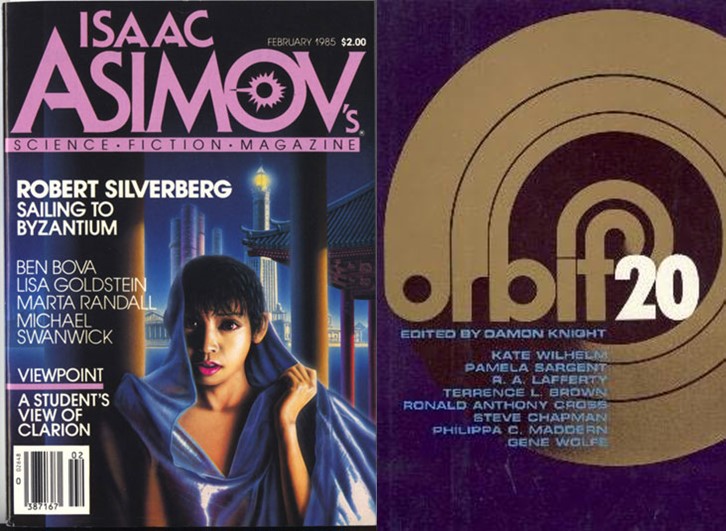Tor Double #10: Robert Silverberg’s Sailing to Byzantium and Gene Wolfe’s Seven American Nights

Cover for Seven American Nights by Bryn Barnard
Seven American Nights was originally published in Orbit 20, edited by Damon Knight and published by Harper & Row in March, 1978. It was nominated for the Hugo Award and the Nebula Award. Seven American Nights is the first of two Wolfe stories to be published in the Tor Doubles series.
Sailing to Byzantium was originally published in Isaac Asimov’s Science Fiction Magazine in February, 1985. It was nominated for the Hugo Award and the Nebula Award, winning the latter. Sailing to Byzantium is the second of five Silverberg stories to be published in the Tor Doubles series and aside from the proto-series Laumer novel, it is the first time an author has been repeated.
Wolfe’s story opens with a short note from Hassan Kerbelai indicating that he is sending the travelogue of Nadan Jaffarzadeh back to his family, noting that Jaffarzadeh seems to have gone missing. The final paragraphs of the story are focused on Jaffarzadeh’s mother’s reaction to the travelogue. The majority of the story is Jaffarzadeh’s description of his first week visiting America.
The American Jaffarzadeh is visiting, however, is one in which the United States failed generations earlier. The Washington, D.C. he travels through is referred to as the Silent City, containing the remnants of the great federal buildings. Although he travels through the ruins and visits a park that he warns is dangerous, the majority of his time in Washington is spent attending the theatre.
During his first day of touring, he notices a man working in one of the buildings in the silent city. He runs into the man at the theatre and learns that he is working on a machine that can emulate handwriting, essentially what we would recognize as an AI with an autopen ability.
After that early visit to see a production of Gore Vidal’s Visit to a Small Planet, he develops an infatuation for the leading lady, Ardis Dahl. That infatuation drives the remainder of the narrative as he begins to stalk her, attending subsequent nights at the theatre, trying to find where she lives, and eventually meeting one of the other actors, Bobby O’Keene, who offers to introduce Jaffarzadeh for a price. When O’Keene tries to pick Jaffarzadeh’s pocket, the police become involved, O’Keene is arrested, and eventually, Dahl tracks down Jaffarzadeh to get his help releasing O’Keene.
The story is told in the form of Jaffarzadeh’s journal, beginning with his arrival aboard a ship and ending after he begins a relationship with Dahl. However, Wolfe introduces several subtle clues throughout the story, in his choice of plays, the descriptions of characters, and incongruities in the way Jaffarzadeh describes things, that indicate that the seemingly straightforward tale is much more convoluted that it would appear.
Upon reading the story, it appears that Jaffarzadeh is somehow the victim of a scam perpetrated by the acting troupe, possibly in conjunction with the manager of the hotel who first sent him to the theatre. However, Wolfe’s choice of plays, one that deals with a traveler attempting to provide a war, the other about a woman who vanishes, indicate that something far more sinister is taking place. Two of Jaffarzadeh’s fellow passengers to America make appearances late in the story. Are they part of the plot? Are the police involved? What about the functionary who sent the journal on to Jaffarzadeh’s family? Wolfe doesn’t offer any real answers and the text, itself, can offer up a Rashomon-like series of answers, none of them more correct than the others.
Seven American Nights feels incomplete. Not only does Wolfe not provide answers to the many questions that are implied, but rarely stated, but he ends the story with Jaffarzadeh’s mother’s not knowing his fate, but knowing he is alive. The reader, on the other hand, is not so sure. Even if Jaffarzadeh can be trusted, and by his own words he notes that he hasn’t included the entire story and has removed pages, the possibility that someone else, possibly even the machine his friend was working with, wrote parts of the journal mean it cannot be trusted.
The described arrest of O’Keene after he tried to pickpocket Jaffarzadeh, in which it is clear that if Jaffarzadeh doesn’t swear out a complaint, the police will arrest him anyway and trump up the charges, coupled with the inability to discover where he is being kept or what happened to him, has chilling parallels with the current situation in which ICE is arresting people and deporting them without due process. Within the context of the story, it also sets the expectation that if the authorities determine that Jaffarzadeh must be removed, there is nothing that anyone could do to stop them or reverse his arrest.
The strength of Seven American Nights is the very infuriating ambiguity with which Wolfe has carefully laced the story.

Orbit 20 cover by an unknown artist
The strength of Seven American Nights is the very infuriating ambiguity with which Wolfe has carefully laced the story.
Silverberg’s world of Sailing to Byzantium is reminiscent of the fin du siècle decadence of Michael Moorcock’s Dancers at the End of Time, which I recently re-read. While Moorcock viewed the world of ever-changing landscape from the point of view of one of the period’s denizens (or citizens as Silverberg calls them), Silverberg’s protagonist, is in the time traveling role of Moorcock’s Mrs. Amelia Underwood. This change makes Silverberg’s world more interesting since it allows the story to offer its own contemporary judgement of the citizens’ self-indulgence.
Of course, Silverberg’s story shares its title with a poem by William Butler Yeats in which Yeats also explores the concepts of immortality, art, and the idea of a paradise. Silverberg has selected as his point of view Charles Phillips, who, without knowing how or why, has been pulled from twentieth century New York to this new world. Phillips moves from city to city accepting of the immortality which seems to exist for the citizens and trying to find his own place among the glories or the past recreations.
When the story opens, he is visiting Alexandria at its height, exploring the Pharos and the library in the company of his lover, Gioia. During this visit, Phillips shares with the reader what he knows of this world. The population of citizens numbers in the low millions. Only five cities exist at any time and they are recreations of historic cities, at the moment the novella begins they include New Chicago, Alexandria, Changan, Asgard, and Timbuctoo. Eventually one of those cities will be dismantled and replaced with another city. These citizen are staffed by “temporaries,” sort of synthetic humans or automatons, Phillips isn’t entire sure.
Even as he enjoys the climb to the top of Pharos, he yearns for a Byzantium which hasn’t been built, but which he is sure will be in time. Before it can be, he and Gioia travel to Changan to enjoy the court of the Chinese Emperor. Their visit there is made more memorable by the fact that Gioia’s friends have arranged from them to be treated as honored guests by the Emperor. During their visit, Phillips begins to see the world beyond the façade. When the Emperor, who is merely a temporary, is not actively engaging, he practically seems to turn off.
The real surprise comes we he sees signs of aging in Gioia, something that shouldn’t happen to the immortal citizens of this era. Gioia leaves him, but arranges for him to have a friend, Belilala, as a companion. Unable to understand what is happening, Phillips chases after Gioia, learning from Belilala that Gioia is a rarity, a citizen who can age and die. Phillips chases after Gioia, despite her stated desire not to see him, reminiscent of Silverberg’s own Born with the Dead, which was the first of Silverberg’s novels to be reprinted in the Tor Double series.
Phillips quest of Gioia introduces him to two other visitors such as himself. The first, Francis Willoughby, is from the late sixteenth century and can’t fathom of the world of miracles Phillips attempts to describe them living in. He is convinced he was simply drugged and dragged to an India ruled by Portuguese (they meet in a recreation of Mohenjo-daro, which replaced Timbuctoo). The second visitor Phillips meets is from a period in his future. Y’ang-Yeovil of the Third Septentriad. Y’ang-Yeovil reveals more about the mechanics of the world, and the manner in which visitors are brought into it, causing Phillips to have an identity crisis of his own.
Eventually, Phillips is able to confront Gioia about her desertion of him and her own aging. While Phillips may be a minority as a visitor, Gioia is a very different type of outsider. A citizen, her recessive trait that causes her to age means that she is still seen as an outsider with little recourse or others who share her affliction. Phillips actually quotes the Yeats poem and Byzantium becomes a promised land where a solution to her affliction might become a possibility, allowing Gioia and Phillips to have a life together without worry of out-aging the other.
The world Silverberg built is a strangely ephemeral world in which the only permanence are its citizens. He focuses on two individuals who lack the immortality that almost everyone else in the world enjoys, and each of them must figure out how to come to terms with that fact in their own way, both coming from very different places. Although it doesn’t seem likely, their story introduces true affection into the world.
Some of the novellas collected in any given volume of Tor Double have links to each other. In the case of this book, both the Wolfe and Silverberg novellas are travelogues of a future earth, with Wolfe exploring the remnants of a post-US Washington and Silverberg looks at a future world that recreates the past.
The cover for Sailing to Byzantium was painted by Brian Waugh. The cover for Seven American Nights was painted by Bryn Barnard.
 Steven H Silver is a twenty-one-time Hugo Award nominee and was the publisher of the Hugo-nominated fanzine Argentus as well as the editor and publisher of ISFiC Press for eight years. He has also edited books for DAW, NESFA Press, and ZNB. His most recent anthology is Alternate Peace and his novel After Hastings was published in 2020. Steven has chaired the first Midwest Construction, Windycon three times, and the SFWA Nebula Conference numerous times. He was programming chair for Chicon 2000 and Vice Chair of Chicon 7.
Steven H Silver is a twenty-one-time Hugo Award nominee and was the publisher of the Hugo-nominated fanzine Argentus as well as the editor and publisher of ISFiC Press for eight years. He has also edited books for DAW, NESFA Press, and ZNB. His most recent anthology is Alternate Peace and his novel After Hastings was published in 2020. Steven has chaired the first Midwest Construction, Windycon three times, and the SFWA Nebula Conference numerous times. He was programming chair for Chicon 2000 and Vice Chair of Chicon 7.